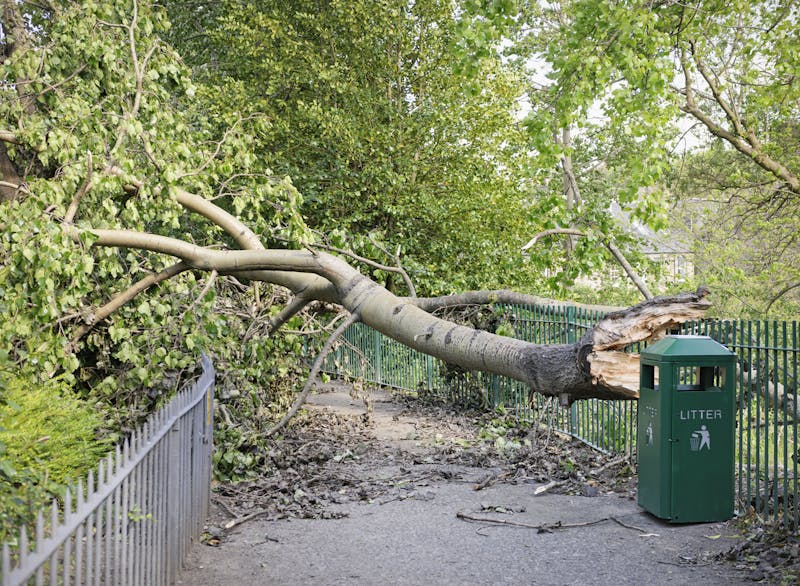
Falling tree branches can cause serious injuries or even fatalities, leaving victims wondering whether they can sue the negligent parties responsible for their damages. In New York, determining liability for such accidents requires a thorough investigation of property ownership, maintenance records, and the application of procedural rules, particularly when municipalities are involved.
Proving Liability for Falling Tree Branch Injuries
To sue for injuries caused by a falling tree branch, you must establish that the defendant was negligent. This typically involves proving:
- Duty of Care: The property owner or entity had a duty to maintain the tree in a reasonably safe condition.
- Breach of Duty: They failed to inspect, maintain, or address known hazards, such as rotting branches or storm-damaged trees.
- Causation: The falling tree branch directly caused your injuries.
- Damages: You suffered measurable harm, such as medical expenses, lost wages, or pain and suffering.
If the property owner can demonstrate that they conducted regular inspections and had no reasonable way to predict the branch’s fall, they may argue that the incident was unforeseeable and avoid liability.
Legal Duty of Tree Maintenance in New York
New York law places a clear responsibility on property owners and municipalities to maintain trees on their premises or public spaces in a reasonably safe condition. Failure to address hazardous conditions, such as weakened or overgrown tree branches, can result in liability for injuries caused by falling branches.
Duty of Private Property Owners to Maintain Trees
Under premises liability laws in New York, private property owners have a duty to ensure that their property, including any trees, does not pose an unreasonable risk of harm to others. This responsibility includes:
- Regular Inspections: Property owners must periodically inspect trees to identify potential hazards, such as rotting branches, signs of disease, or structural weaknesses caused by storms or other natural events.
- Timely Maintenance: If a tree exhibits signs of damage or instability, property owners must take appropriate action, such as trimming overgrown branches, removing diseased limbs, or cutting down a dead or unstable tree entirely.
- Foreseeable Hazards: Property owners are only liable if the danger was foreseeable. For example, if a reasonable inspection would have revealed a decayed branch, the property owner could be held responsible for failing to address the issue.
If a property owner neglects these duties and a falling branch causes injury, they can be sued for negligence. Importantly, liability does not extend to unforeseeable events, such as a healthy tree suddenly falling during an extraordinary storm.
Responsibilities of Landlords for Trees on Rental Properties
In cases where a property is rented, the landlord typically retains responsibility for maintaining trees on the property unless otherwise specified in the lease agreement. If a tenant or visitor is injured by a falling branch due to the landlord’s failure to address a hazardous condition, the landlord may be held liable.
Duty of Municipalities to Maintain Trees on Public Property
Municipalities, such as cities or towns, are responsible for maintaining trees located on public property, including sidewalks, parks, and streets. The same legal principles of duty, breach, and foreseeability apply to government entities. Based on this, when suing a municipality, additional procedural rules and legal doctrines come into play:
- Notice of Hazard: To hold a municipality liable, the injured party must prove that the government entity knew or should have known about the hazardous tree condition. This can be established through prior complaints, reports, or evidence of obvious decay or damage.
- Reasonable Opportunity to Act: Once a municipality is aware of a hazard, it must have had a reasonable amount of time to address the issue before the accident occurred.
- Government Immunity and Procedural Requirements: Municipalities enjoy certain protections under sovereign immunity laws. To bring a claim, the injured party must comply with strict procedural requirements, including:
- Filing a Notice of Claim: Under New York General Municipal Law § 50-e, injured parties must file a formal notice of claim within 90 days of the incident. This notice provides the municipality with the opportunity to investigate and potentially resolve the matter before litigation.
- Time Limitations: After filing the notice of claim, the injured party typically has one year and 90 days from the date of the incident to file a lawsuit against the municipality.
Failure to comply with these procedural requirements can result in the dismissal of the claim, regardless of its merits.
Public Utility Companies and Tree Maintenance
In some cases, trees on public or private property may interfere with power lines, creating additional risks of falling branches or electrocution. Public utility companies may share responsibility for maintaining trees in proximity to power lines. For example:
- If a utility company negligently fails to trim trees encroaching on power lines, leading to a falling branch or tree collapse, they could be held liable for resulting injuries.
Liability in Neighboring Property Cases
New York law also addresses situations where a tree on one property causes harm on an adjoining property. For example, if a tree branch overhangs a neighbor’s yard and falls, causing injury, the owner of the tree could be held liable if:
- The hazardous condition was visible and known.
- The owner failed to take corrective action despite being aware of the risk.
In such cases, the injured party may recover damages through a premises liability claim against the negligent property owner.
Comparative Negligence in New York Tree Injury Cases
New York follows a comparative negligence rule, which means that if the injured party is partially at fault for the accident, their compensation will be reduced by their percentage of fault. For instance, if you were trespassing on private property or ignoring warnings about hazardous areas, the court may assign partial liability to you, potentially reducing your recovery.
Damages You Can Recover in Falling Tree Branch Cases
If you successfully prove liability, you may recover damages for:
- Medical Expenses: Hospital bills, rehabilitation, and future medical care.
- Lost Wages: Compensation for time missed at work due to your injuries.
- Pain and Suffering: Damages for the physical and emotional impact of the accident.
- Wrongful Death: If a falling branch caused a fatality, surviving family members may recover damages for funeral expenses, lost income, and loss of companionship.
What to Do After a Falling Tree Branch Injury in New York
If you are injured by a falling tree branch, taking the following steps can strengthen your case:
- Seek Medical Attention: Your health and safety are the top priorities. Obtain prompt medical care for your injuries and keep detailed records.
- Document the Scene: Take photographs of the tree, the branch, your injuries, and the surrounding area.
- Identify Witnesses: Obtain contact information for anyone who witnessed the incident.
- Report the Incident: Notify the property owner, landlord, or municipality responsible for the tree maintenance.
- Consult an Attorney: A New York premises liability attorney can evaluate your case, identify liable parties, and establish their negligence to recover full damages for you.
Challenges in Suing for Falling Tree Branch Injuries
Falling tree branch cases can be legally complex due to several factors, including:
- Proving Notice: You must demonstrate that the property owner or municipality had prior knowledge of the hazardous condition.
- Weather Events: If the branch fell during a severe storm or other uncontrollable event, the defendant may argue that it was an "act of God," absolving them of liability.
- Sovereign Immunity: Claims against government entities involve strict procedural rules, including shorter deadlines and potential immunity defenses.
How an Experienced New York Personal Injury Lawyer Can Help
Navigating a falling tree branch injury claim requires a thorough understanding of premises liability, municipal liability, and New York's comparative negligence laws. An experienced personal injury lawyer can:
- Investigate the incident and gather evidence, such as maintenance records and eyewitness accounts.
- Identify all potentially liable parties, including private property owners and municipalities.
- Handle communications and negotiations with insurance companies to ensure you receive fair compensation.
- File a lawsuit and prepare for trial if a fair settlement cannot be reached.
Choose Our Proven New York Premises Liability Lawyer to Recover Maximum Damages
If you or a loved one has been injured due to unsafe conditions on someone else’s property, trust the New York premises liability attorneys at The Law Offices of Michael S. Lamonsoff, PLLC to fight for the justice and compensation you need. Backed by over 150 years of combined litigation experience and a formidable track record of more than $500 million in settlements and verdicts, our team has the skills and determination to hold negligent property owners accountable. To schedule your free consultation, call us at 212-962-1020 or fill out this online contact form.


